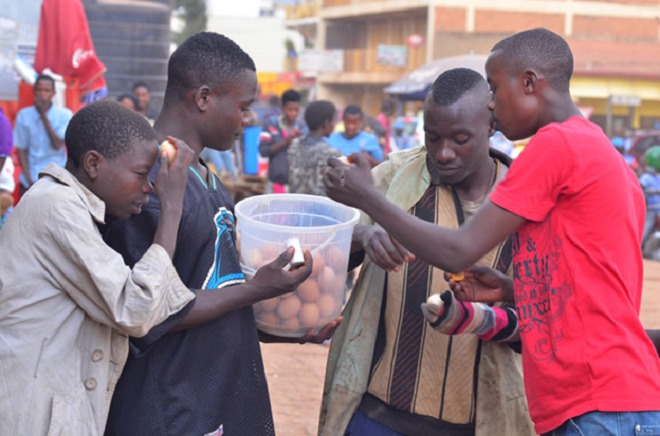During the 2014 annual dialogue on December 19, malnutrition was one of the problems at the center stage. At the time, 48% of children below five years were stunted. This had slightly dropped from 54% in 2010.
It was resolved thereafter that Rwandans should aim at promoting healthy living practices, especially balanced diets.
However, not much has been done to improve the situation. The population still suffers high levels of stuntedness, primarily caused by poor diets, and not the lack of food.
To some extent, participants argued, “this is out of our own carelessness. Local leaders were tasked to fix the matter, because it had become annoyingly a recurrent subject.
The basis for the argument is that there is a lot of improvement in agriculture; the one cow per poor family for milk, the chickens running around homes for eggs, vegetables.
It’s about putting all that on the plate and make sure that child have something to eat, participants concluded.
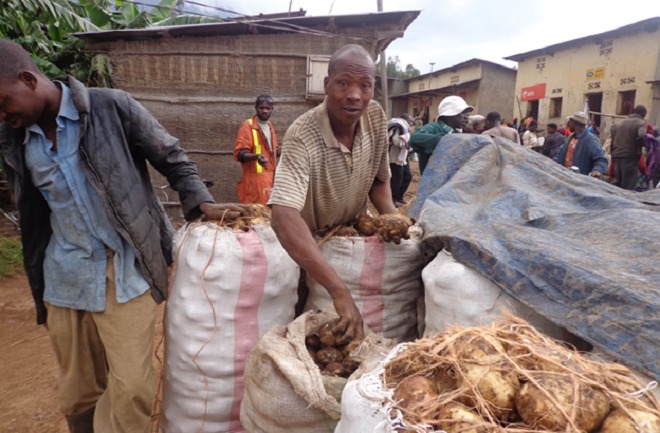
Irish potatoes are Rwanda’s common food crop rich in proteins. Irish production has increased in the past years after research to improve various varieties
Stunting could be attributed to carelessness of parents in most cases.
In August 2015, Gaspard Mbonyiyeze 40, a father of six from Cyanika sector, Burera district in Northern Province ate an egg for the first time in many years.
He bought a boiled egg from a street vendor in Musanze town where he had gone to sell two tons of Irish potatoes.
He says his children’s bodies, including the last born, aged 4, have never known the egg’s proteins.
An egg in his town is worth Rwf100 ($0.1), while a chicken costs Rwf2000 ($2.6). Every Rwandan household can rear chicken and eat eggs, but Mbonyiyeze told KT Press there is an excuse not to own one.
“I cannot rear chicken in the middle of farms of neighbors. Chicken predate on germinating crops.”
However, Mbonyiyeze and family only eat meat during the festive season on two most important days of the year- Christmas and the New Year. He buys a kilo of beef at Rwf2000.
Mbonyiyeze’s children can only drink milk, “once in a while when a cow of a neighbor has produced a calf and the owner invites them for milk in a sign of celebration.”
Although Mbonyiyeze obtains a sizeable income from Irish production he has fed his family only on Irish potatoes and beans.
He does not find any need to vary the family menu. “My children are fine with this meal; the most important is to make sure they have enough, the rest is luxury.”
Many Rwandan families are still behaving like Mbonyiyeze’s in relation to feeding habits and diet.
The government is concerned this trend is taking toll on the population.
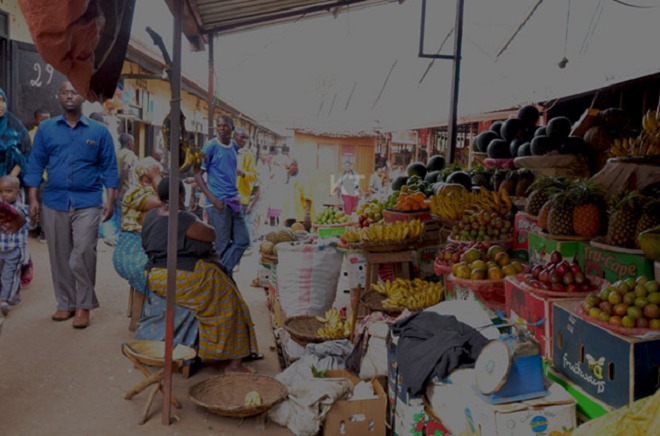
Traders at Kimironko market in Kigali selling various fruits and vegetables. There are several government initiatives that aim at improving nutrition among families in the country to cut down on stunted growth
Several initiatives have been introduced, such as bringing women of one village together in an evening group discussion. Each comes with what they can afford; beans, vegetables, cooking oil, etc to learn how to cook. They are supervised by a community health worker sent by a nearby health center.
Eliab Ntakirutimana, a nutritionist from Buruhukiro Health Center in Nyamagabe district says the initiative is paying off.
Local leaders are trying to encourage an initiative of contributing a litter of milk per child in their area and a vegetable garden to improve family diets.
“A meal including Irish potatoes and beans, supported by vegetables from the garden which is afforded by every Rwandan can be the way to go,” Ntakirutimana says.
They are also suggesting silver fish, palm oil to add in lipids and an avocado from a tree in the backyard.
“There is one simple reason why we don’t get it right; some of us are quit careless,” admits Speciose Mukamana, a mother of three from Gatumba sector in Ngororero district, Western Province.
The government wants a well articulated program that would stop stunting for good, not some initiatives that do not deliver a long-term result.
“I am not sure anybody enjoys seeing a big part of our children population stunted when we have means to prevent that or to deal with that,” a participant said during Umushyikirano.
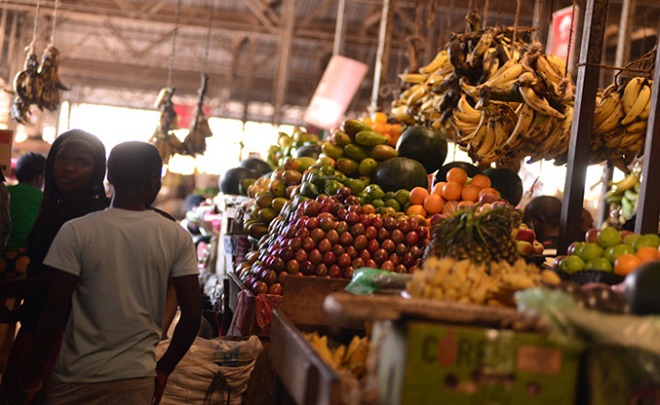
The rate Crop production in Rwanda has surpassed population growth implying the country has food surplus
The recent household survey (EICV4) indicated that Rwanda’s population grew by 2.6%, against a crop growth of 4.8% between 2002 and 2006. Then between 2007 and 2014, it was 2.5% population growth against 5.8% crop growth.
However, for the last 15 years, crop growth in Rwanda is twice greater than population growth. The country has surplus. Barely 90 % of the Rwandan households have agrarian land which is suitable for agriculture due to the country’s tropical climate and fertile land.
The land is supported by fertilizers which costs the country Rwf45billion ($62.3million) in subsidy every year. Farmers also use manure from the cows provided under the one cow per poor family initiative. About 300,000 cows were given free of charge to poor families around the country since 2006 on top of other initiatives.
About 52% of Rwandan households own at least one cow, according to the household survey.
They not only give manure, but also increase production of milk, currently standing at 445,000,000 liters per year, according to national dairy strategy-2013.
Currently, each of the 11 million population of the country takes a share of 40.4 liters per year, or 0.1 liters a day.
The target is to increase production to 650 million liters by 2017, and then 1.9 million liters in 2020, to allow every Rwandan 80 liters of milk annually.
Rwandans also rear livestock, such as pigs, goats, and poultry. All these sources of food should allow Rwandans to afford a balanced diet.
Meanwhile, the parliament has resolved to make malnutrition a priority focus in 2016. Members of parliament are visiting villages with high levels of malnutrition to engage the local officials on how to combat the vice.
Hopefully Mbonyiyeze will be persuaded to revise his family’s diet and save his children from the avoidable misery.
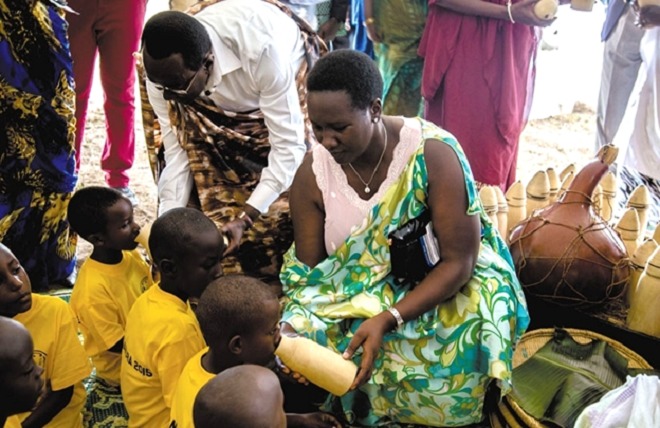
Bernard Makuza the Rwanda Senate President feeding children with milk during the national Umuganura day -a traditional cultural event that used to bring communities together to share seasonal agricultural produce.

